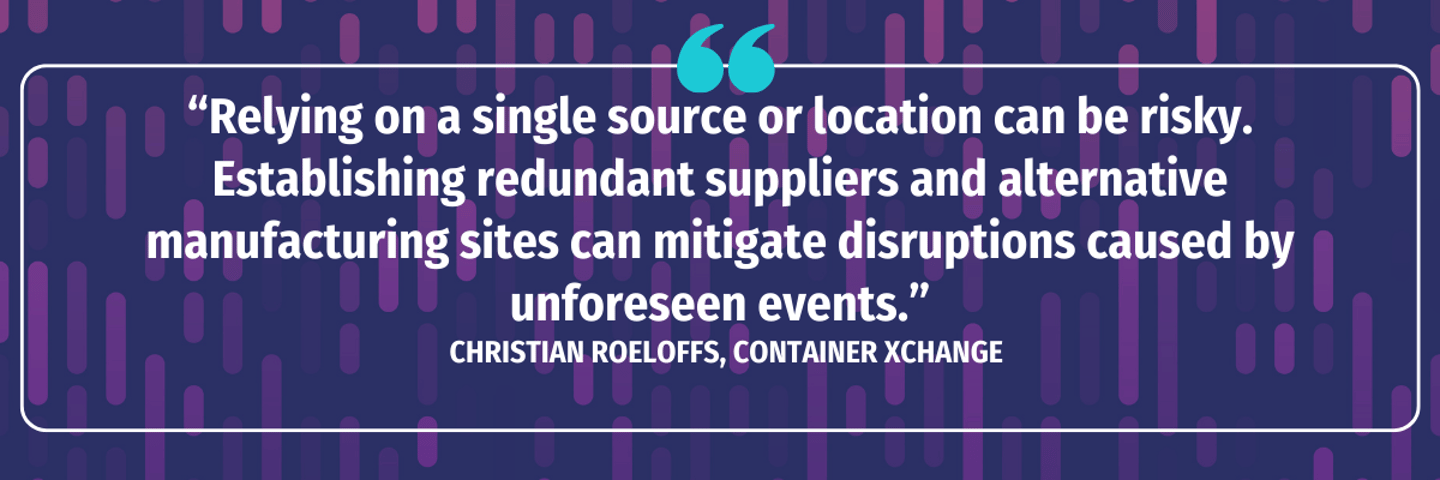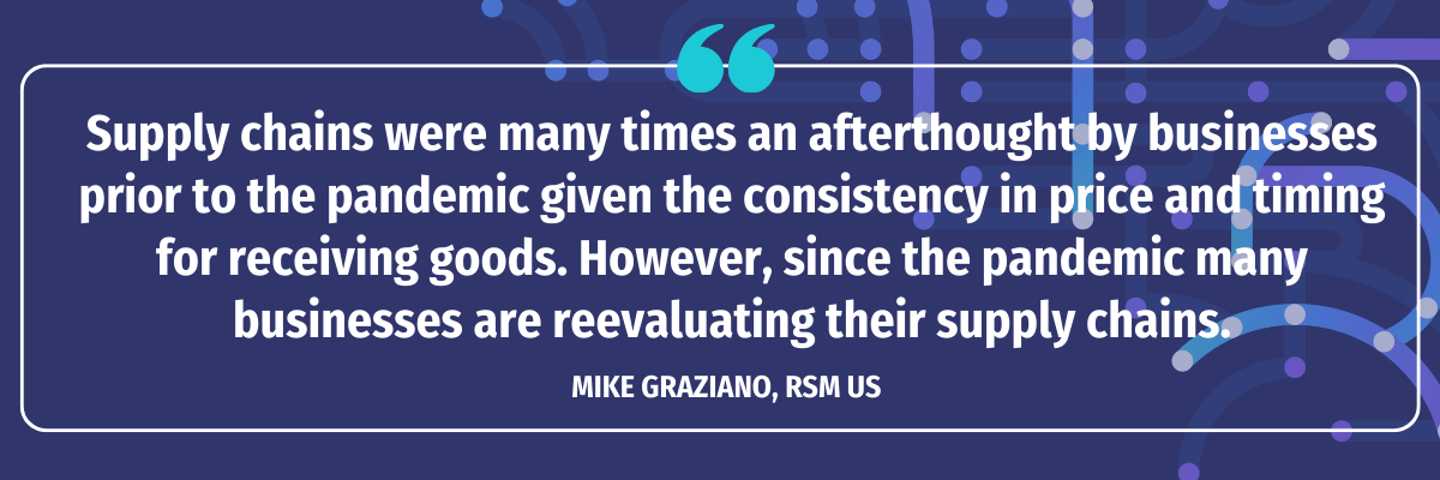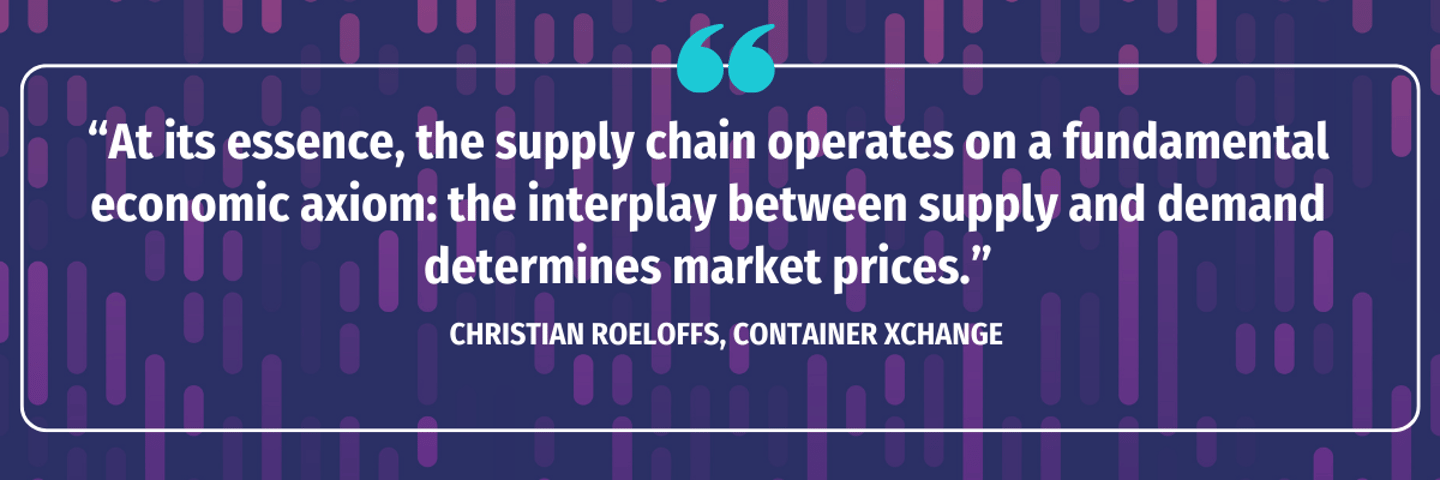Supply Chain Issues Today
The global supply chain is so complex today that it can be difficult to determine which areas are having the greatest impact on its success and which supply chain technology trends are worth following.
From shifting weather patterns to economic uncertainty to geopolitical volatility, the modern supply chain grows exponentially more vulnerable.
Why is the supply chain so messed up right now?
The industry has been plagued by global supply chain issues over the last several years, but recently many top consumer brands have been encountering new problems. Why? According to Mike Graziano, consumer products senior analyst with RSM US, companies today are more focused on inventory and manufacturing visibility and supplier lead times.
“The biggest challenge today is being better able to predict demand so that inventory levels can be better managed and mitigate the risk of excess inventory, which will result in margin compression over the longer term as discounting strategies are implemented to sell through older products,” he says.
At the forefront of supply chain issues today are also labor shortages and climate change. For example, Douglas Kent, EVP of strategy and alliances at the Association for Supply Chain Management (ASCM), says that low water levels and the subsequent pile-up of vessels in the Panama Canal are causing congestion.
“Typically, around 90 ships pass through the canal daily, but due to the drought; that number has almost doubled,” says Kent. “Long product delays will have a ripple effect on consumer goods retailers and consumers as we approach the holiday shopping season.
Overall, the logistics system for retailers is vulnerable. Kent references the recent UPS labor negotiations as an example, during which retailers had to “worry and brace for higher shipping costs, delays, and capacity constraints.”
“Unfortunately, supply chain disruptions have an inevitable impact on consumer confidence and buying behaviors leading to the bullwhip effect, which is something retailers need to be aware of in the coming months,” Kent says.
What are the 3 main factors that contribute to supply chain disruptions?
What causes the supply chain to be so vulnerable? Its success is dependent on myriad factors, spanning economic health, weather, consumer trends, and so much more. That’s why it’s essential to delve into the core principles of supply chain dynamics, according to Christian Roeloffs, co-founder and CEO of Container xChange, an online container logistics operating platform.
“At its essence, the supply chain operates on a fundamental economic axiom: the interplay between supply and demand determines market prices,” says Roeloffs. “This delicate equilibrium means that any perturbation in one aspect reverberates across the entire system, influencing the others in a cascading fashion. Consequently, these fluctuations often trigger a cyclical ebb and flow within global supply chains.”
Over the past three years, these fluctuations have been primarily caused by the pandemic or geopolitical upheavals like the war in Ukraine, according to Roeloffs.
“These events have engendered a series of domino effects — ranging from inflationary pressures to economic recession, labor strikes, surplus production capacity, and broader supply imbalances — all of which have had a compounding effect on the consumer goods supply chain,” he says.
One of the primary pain points has been a significant shift in consumer behavior across the U.S. and Europe, causing an imbalance between supply and demand, he notes.
“This incongruity has resulted in abundant capacity in shipping terminology relative to consumer requirements, thereby precipitating a downward pressure on prices. This trend encapsulates the prevailing scenario within the global economy today,” adds Roeloffs.
“In summary, the consumer goods supply chain is intricately intertwined with the delicate interplay of supply, demand, and pricing dynamics,” he emphasized.
What are the current supply chain issues in the world and U.S. today?
While it may seem we are in a post-pandemic world in some areas, when it comes to supply chain trends, pandemic disruptions continue to cause upheaval. In the early days, the pandemic led to factory shutdowns, labor shortages, and disruption in transportation, which caused delays in production and distribution, according to Sourav Banerjee, Infosys SVP and Industry Head – Consumer Retails & Logistics.
“These disruptions highlighted the vulnerability of global supply chains and we are still experiencing the impacts,” he added.
In addition, Banerjee points to transportation and labor issues such as container shortages, port congestion and a lack of available shipping vessels. What further exacerbated the problem, he says, is a shortage of transport workers and warehouse space.
He also points to outdated supply chain and inventory management practices as posing a challenge, as they couldn’t adapt to the unpredictable shifts in demand and consumer trends as companies struggled simultaneously with excess inventory and stockouts.
Lastly, reshoring or nearshoring, which Gregorchik explained is the act of relocating manufacturing from APAC countries to North American regions, will add new stress to North American logistics.
“While Class-I railroads have worked hard to improve connectivity between MEX-USA-CAN, it still hasn’t experienced the surge in volumes that are bound to come with heightened manufacturing output in North America,” he adds.
What would need to happen to solve the ongoing supply chain issues?
The key to solving ongoing supply and demand issues today? According to Roeloffs, it’s “a combination of strategic planning, technology adoption, risk management, collaboration, and adaptability.”
“Supply chain cost management, risk management, and sustainability are key concerns for many supply chain officers,” he added.
As a result, companies should be diversifying their supply, manufacturing, and distribution sources, he recommends.
“Relying on a single source or location can be risky. Establishing redundant suppliers and alternative manufacturing sites can mitigate disruptions caused by unforeseen events,” he added.
Additionally, consumer goods companies should look to strengthen their relationships with suppliers, as improved collaboration and shared risk assessment should lead to clear communication and better management of supply chain disruption, he says.
A key focus area is also demand forecasting, as companies will need to address demand fluctuations amid the volatile environment. This means tech-backed forecasting with improved data analysis of inventory, demand, and surplus, according to Roeloffs.
“Establishing flexible and resilient logistics networks can mitigate delays caused by transportation disruptions. Diversifying transportation modes and routes can help ensure smoother operations,” he says.
Is the global supply chain improving in 2023?
While more stable than it has been in the past, the supply chain environment is dealing with a host of new problems, according to Tom Madrecki, VP of supply chain at the Consumer Brands Association.
“Manufacturers are contending with new challenges presented by the current, transitional phase we’re in today. The industry is doing everything possible – from integrating technologies designed to enhance operational improvements, to supporting public-private partnerships aimed at boosting visibility – to build resilient supply chains that will withstand more severe disruptions that may emerge in the years to come,” he says.
And the supply chain only continues to evolve. Roeloffs says companies are adjusting their strategies to strengthen their supply chains and make them more flexible.
“One major change is that companies are becoming more diverse in how they get their supplies. The topic of ‘diversification of supply chain’ and ‘minimisation of logistics risks’ is not new,” says Roeloggs. The efforts of nations and companies are only strengthening in this direction with a goal to reduce over-reliance on one market for supply chain. Companies are now evaluating and taking initiatives that test the waters with venturing into new markets for fulfilling their supply chain needs as a China plus one strategy.”
This is resulting in smaller trade networks, Roeloffs says.
“Things don't just go from China to the U.S. in a straight line. Instead, there are more stops in different places,” he says. “This means there's a growing need for smaller ships, and these new trade routes might take longer, but they're safer and more flexible.”
And in order to improve current supply and demand issues, companies are paying attention to sustainability; environmental, social, and governance pressures; collaborative partnerships, and more, says Roeloffs.
“Nonetheless, uncertainties persist,” he emphasized. “Ongoing developments in China and Ukraine serve as reminders of the unpredictability of global events. The prospect of manufacturing setbacks, lockdowns, or geopolitical tensions introduces a layer of complexity that necessitates vigilance.”
Which raw materials are in short supply?
At the top of the list for supply chain storages relevant to the consumer goods industry is CO2.
“On top of this, imposing tariffs that would drive up the cost of tin mill steel could certainly spark new supply chain issues,” says Madrecki. “U.S. steel manufacturers are only capable of meeting 50% of total demand from U.S. can manufacturers, and a lack of access to a product so ubiquitous in consumers’ everyday lives would be felt far and wide.”
What are the predictions for 2023 supply chain?
With the increasing use of artificial intelligence, it’s becoming easier to predict what’s to come down the supply chain pipeline. According to Gartner, companies will either be looking to scale or optimize tech applications, or find emerging technologies that will help them stand apart from competitors. Among the areas of focus will be smart operations, actionable AI, cloud platforms, composable architecture, mobile optimization, and more.
Additionally, consumer goods companies will be putting a special emphasis on resilience, says Banerjee. “Trying to adapt to factors such as pandemics, natural disasters, geopolitical events, and supply chain bottlenecks.”
A result of these investments will be supply chains that can better deliver hyper-personalized products and experiences, says Banerjee. Additionally, more localized and agile production.
RSM’s Mike Graziano notes that supply chains were often an afterthought by businesses prior to the pandemic given the consistency in price and timing for receiving goods. Now, of course, many are reevaluating their supply chains, and he predicts they’ll continue to do so to mitigate single-source risks and shift production closer to the end consumer to reduce the time to market.






